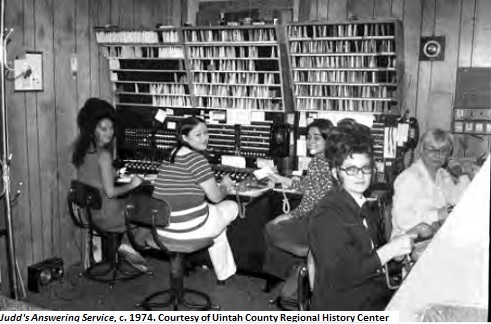Dublin Core
Title
Description
You call, you text, you surf the net. You spend countless hours on your phone. Learn how the telephone transformed Utah’s remote Uinta Basin.
When the telephone reached Utah’s remote Uinta Basin at the turn of the twentieth century, it completely transformed the way residents communicated and unlocked new job opportunities.
Telephone operators were vital to making the new phone system work. Phone lines linked to a central switchboard required an operator to connect one caller to another. The first telephone operators were boys, who often lacked the temperament needed to soothe customers irritated by the crackling noise on the primitive system. So telephone companies recruited well-spoken women instead. As the human face of the telephone company, an operator was the “disembodied but reassuring voice of a new technology that was changing the world…with dizzying speed.” Switchboards ran 24-hours-a-day and were defacto community hubs. In addition to connecting calls, rural operators provided the time and weather, the latest game score, or even a wake-up call. In Vernal, the operator was the fire alarm system, taking emergency calls and coordinating with the fire department. Essie Neal ran the Uintah Telephone Office out of her Vernal home. She trained and managed a team of operators, juggling her job and home-life in close quarters. It wasn’t until 1962 that rotary-dial phones – which did not rely on an operator – finally came to Vernal.
This didn’t eliminate the need for operators, however. Some businesses – like medical doctors – required a 24-hour answering service for their customers. So entrepreneurs like Donna and Frank Judd opened their Vernal-based answering service in 1960. They served 27 companies their first year, and by 1974 had eleven operators handling their 300 switchboard and 400 mobile radio accounts. The work was exhausting. Frank said that his wife “goes on shift at 6:00am after being up about six times… assisting the night operator, and then works until 10:00pm.” For her part, Donna quipped one October, “The last time I was out of the house was in March.”
Telephones keep advancing. Our use of them evolves. But the women who originally made the phone lines work will not be forgotten.
Creator
LeeAnn Denzer for the Uintah County Heritage Museum © 2017
Source
Image: Donna Judd (right in white blouse) and her employees at Judd’s Answering Service, Vernal, Utah, circa 1974. Telephone operators were trained in switchboard technique and deportment. Considered educated and well spoken, the female switchboard operator emerged as an important, even iconic, figure in American culture during the first few decades of the twentieth century. Image Courtesy of Uintah County Regional History Center.
_______________
See LeeAnn Denzer, “Basin Telecommunication: Hello, Are You There? Connecting through Telecommunication,” Outlaw Trail Journal, Vernal, UT: Uintah County Regional History Center, Winter 2016; and Uintah County Heritage Museum, exhibition file for “Hello, Are You There? Connecting through Telecommunication,” curated by LeeAnn Denzer, 2016.

